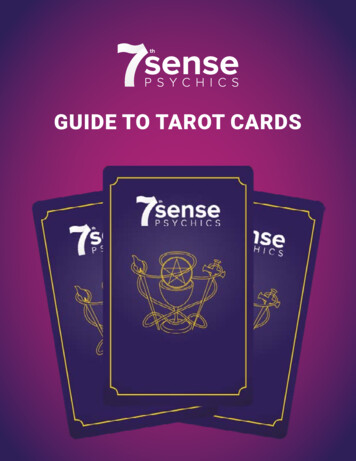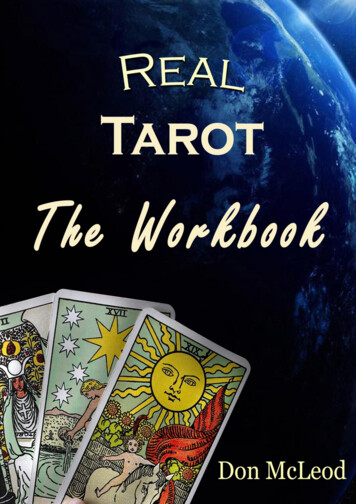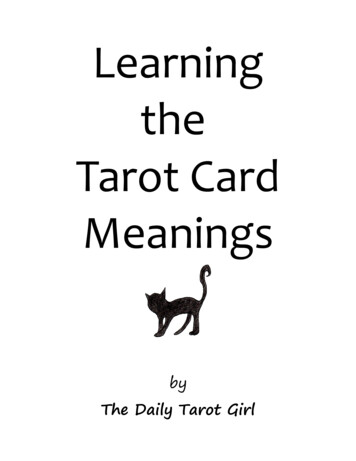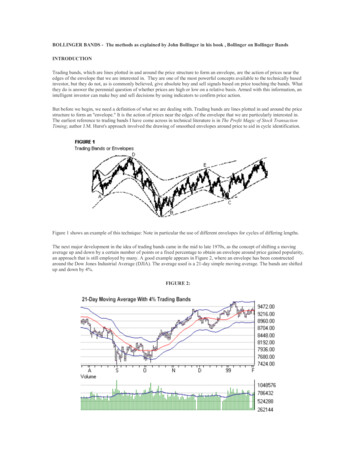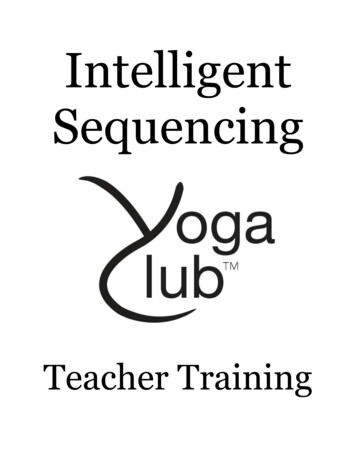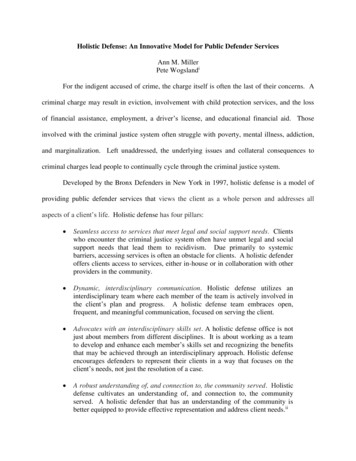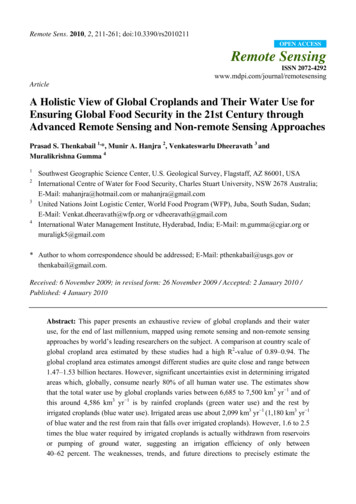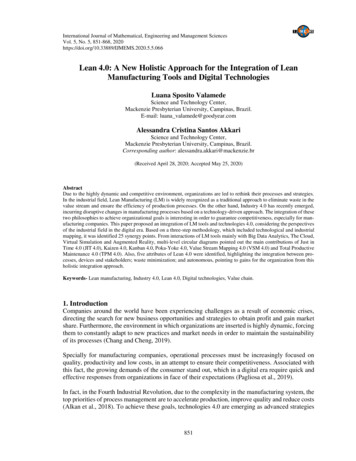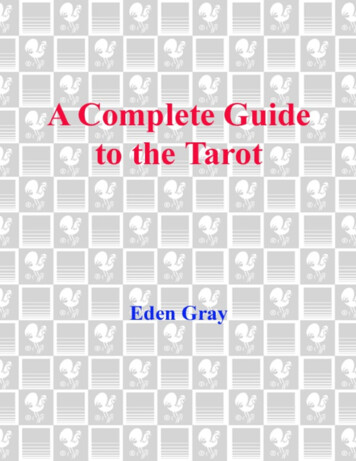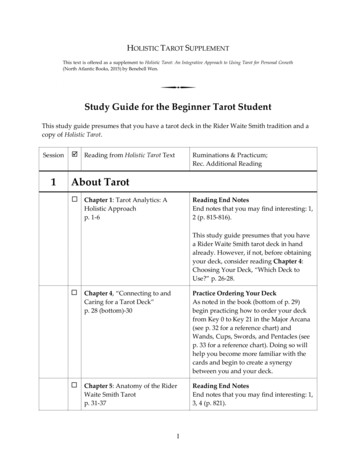
Transcription
HOLISTIC TAROT SUPPLEMENTThis text is offered as a supplement to Holistic Tarot: An Integrative Approach to Using Tarot for Personal Growth(North Atlantic Books, 2015) by Benebell Wen.Study Guide for the Beginner Tarot StudentThis study guide presumes that you have a tarot deck in the Rider Waite Smith tradition and acopy of Holistic Tarot.Session1 Reading from Holistic Tarot TextRuminations & Practicum;Rec. Additional ReadingAbout Tarot Chapter 1: Tarot Analytics: AReading End NotesEnd notes that you may find interesting: 1,2 (p. 815-816).Holistic Approachp. 1-6This study guide presumes that you havea Rider Waite Smith tarot deck in handalready. However, if not, before obtainingyour deck, consider reading Chapter 4:Choosing Your Deck, “Which Deck toUse?” p. 26-28. Chapter 4, “Connecting to andPractice Ordering Your DeckAs noted in the book (bottom of p. 29)begin practicing how to order your deckfrom Key 0 to Key 21 in the Major Arcana(see p. 32 for a reference chart) andWands, Cups, Swords, and Pentacles (seep. 33 for a reference chart). Doing so willhelp you become more familiar with thecards and begin to create a synergybetween you and your deck.Caring for a Tarot Deck”p. 28 (bottom)-30 Chapter 5: Anatomy of the RiderWaite Smith Tarotp. 31-371Reading End NotesEnd notes that you may find interesting: 1,3, 4 (p. 821).
HOLISTIC TAROT SUPPLEMENT Chapter 2: A Concise HistoryThe Holistic Tarot text is an inadequatesource for tarot history. To learn moreabout the subject, read the works ofGertrude Moakley, Michael Dummett,Brian Williams, Paul Huson, Robert M.Place, and of course, the volumes of StuartKaplan’s The Encyclopedia of Tarot.Lessonp. 7-11Reading End NotesEnd notes that you may find interesting:15, 16 (p. 817); 19, 20, 22 (p. 818); 26 (p.818-819); and 27, 29 (p. 819). Chapter 3: Allaying Fears andSelect Card RuminationsFrom your deck, pull out the cardsreferenced in the chapter and study thosecards as you read along in the chapter.Offering Theoriesp. 12-25Reading End NotesEnd notes that you may find interesting: 1(p. 820), 11 (p. 821).2Beginner Practice Chapter 6: The Personal JournalJournalingStart a tarot journal to keep track of yourstudies.p. 38-41 Chapter 7: Beginner Rote LearningSupplement: Log of Readingsp. 42-44(Download from tic-tarot-supplements/)Use the supplemental download to logyour practice readings. Each practice thatis recommended in this guide has acorresponding log entry in the download. Chapter 13: On Shuffling, Cutting,and Drawingp. 277-2822Direct Flip vs. Turn OverDecide which method of drawing cardssuits you best. The Direct Flip method isillustrated on p. 281; the Turn Over
STUDY GUIDE FOR THE BEGINNER TAROT STUDENTmethod is on p. 282.Reading End NotesEnd notes that you may find interesting: 1(p. 833), 4 (p. 833-834) Chapter 14, “One-Card Draw”p. 284-287See also Chapter 9 for looking upcard meanings.Open Book Practice: One Card DrawShuffle the deck and cut per the guidelinesin Chapter 13. Concentrate on being openand receptive to what messages the cardsmight have to offer you.Ask the cards: What do I most need to knowabout my life path right now?See alsoChapter 15, “Checklist ofRecommended Exercises”p. 460 (top)Pull a single card per any approach thatfeels right intuitively to you. Look up themeaning of that single card in Chapter 9.Log the reading practice in your journal.Note the first bullet point on p. 460.Follow the exercise and log your progressin your tarot journal. Chapter 14, “Three-Card Spread”p. 290-293 only(Do not read “Alternative ThreeCard Spread” section yet.)See also Chapter 9 for looking upcard meanings.Open Book Practice: Three Card SpreadRead about the Three-Card Spread only.Do not read onward about the AlternativeThree-Card Spread (p. 293).Concentrate on being open and receptiveto what messages the cards might have tooffer you. Ask the cards: Give me a snapshotof my life right now as it is and where I amheaded.Shuffle, cut, and draw cards into the threecard spread. Note what each card positionsignifies. Look up the meaning of eachcard in Chapter 9. Log the reading practicein your journal.3
HOLISTIC TAROT SUPPLEMENT Chapter 15, “How Frequently MaySeekers Consult the Tarot”p. 456-457 (only) Chapter 20: Reading Tarot forFor now, read the case studies (p. 508-516)only to gain a general sense of how tarotpractitioners read for themselves and howintuitive-creativity can be triggered. Donot worry too much about the discussionof tarot spreads being used or the cardmeanings, though it is recommended thatyou take the time to look up some of thesample cards in the Cyclopedia tounderstand the interpretation rationales.Yourselfp. 506-5163Rumination.Think about why you have decided tolearn tarot. What is the purpose behindyour study? How will you be using tarot?Becoming Familiar with Card Imagery Chapter 5, Tables on p. 32 and 33See alsoChapter 15, “Checklist ofRecommended Exercises”p. 459 (bottom)Ordering Your Deck, ContinuedContinue to practice ordering your deck,from Key 0 to Key 21 in the Major Arcana(see p. 32 for a reference chart) andWands, Cups, Swords, and Pentacles (seep. 33 for a reference chart).Also, you will need an ordered deck forthe next practicum. Chapter 8: KeywordsLearning KeywordsWith your ordered deck in hand, followalong Chapter 8 and review the givenkeywords for each card. Some may ringtrue for you and some may not. Don’tworry about any dissonance for now.Later on, however, you should revisitthese pages in the book and manuallycross or white out the keywords that don’twork for you and write in your own. Fornow, simply follow along with an openmind, reading both for upright meaningsand reversals.p. 45-584
STUDY GUIDE FOR THE BEGINNER TAROT STUDENT Chapter 15, “Card Reversals”Three-Card Reading (with Reversals)If you haven’t already, shuffle your cardsso that they are randomized upright andreversed. Practice three card readings withreversals, using the WIND mnemonic. Logthe reading practices in your journal. Do atleast two practice readings with reversals.p. 427 (bottom) - 4324The Major Arcana Chapter 9: Cyclopedia of CardOne Card Intensive StudyGather p. 63-234 in your hands while thebook is resting on a tabletop (this willwork with the hard copy of the book only,obviously). Close your eyes, relax, and tryto be open and receptive. Turn randomlyto any entry in the section and note whichcard you selected. Locate that card fromyour tarot deck. Do an intensive study ofthat card, ruminating on the following:Meaningsp. 59-60 What story does the imagery of the cardseem to tell? Are there any secondary stories going on inthe background of the card, or among theother figures? How would you describe the expressionson the faces of any characters depicted? Are any archetypal figures featured in thecard? What is the dominant color scheme in thecard? Are there any historical, religious, ormythical references in the cards? Note every symbol in the card and considerwhat each symbol might represent to you. When you flip the card over in reverse,how do your impressions of the cardchange?After you have ruminated on the card,read the Cyclopedia entry for the card andany corresponding end notes. Also reviewthe keywords on p. 47-58. How do yourimpressions of the card align with the5
HOLISTIC TAROT SUPPLEMENTkeywords? If there is no alignment, notethat in the margins of the Keywordssection for your own future reference.The one card intensive study can be done forevery card until you have completed such astudy for all 78. Chapter 9, “Major Arcana”The Majors: Card RuminationsWith your ordered deck in hand, followalong Chapter 9, card by card througheach Major Arcanum or Trump card.p. 61-125Reading End NotesEnd notes that you may find interesting: 5(p. 822); 6 (p. 822-823); 7 (p. 823). Also,significant contextual information andsymbolic interpretations were left out ofthe main text and reserved for the endnotes corresponding to each MajorArcanum entry. E.g., 10 (p. 823) for TheFool; 11 (p. 823) for The Magician; 12 (p.823) on the lemniscate; 18 and 19 (p. 824825) for The High Priestess; 31 (p.825) forThe Lovers, on the Tree of Knowledge andthe Tree of Life, etc. Chapter 15, “The Significance of the Rumination and PracticumMajor Arcana”p. 426 (bottom) - 427Shuffle the deck and think about pastevents in your life that felt beyond yourcontrol and ask generally: What archetypalforces tend to govern my life path? Thendraw cards one by one from the deck,turning them face up, counting each cardas you draw until you draw a MajorArcanum card. Note how many cards ittook. This number will be revisited at theend of the exercise.Look up the Cyclopedia entry for theMajor Arcanum card drawn. Ignore cardreversals for this exercise and focus on theupright meaning and essence of the card6
STUDY GUIDE FOR THE BEGINNER TAROT STUDENTonly. Ruminate on how that card appliesto your life path and your experiences.Return to the number of cards it took toreach the Major Arcanum card. If the totalnumber is over 9 cards (i.e., double digits),add the digits together until the sum is asingle digit. E.g., If the first MajorArcanum card to appear is the 28th card,add 2 8 for 11. Since 11 is still a doubledigit, add 1 1 for 2. Read thecorresponding Life Path entry for thatnumber in Appendix G, p. 787-794, butnote that this result is not your Life Pathnumber. Use the Life Path entry inAppendix G only to get a general sense ofthat number’s metaphysical significance towhy certain archetypal (Major Arcanum)forces tend to govern your life. Notefurther the master numbers 11 and 22 onp. 795. Also look up that single digitnumber (1-9) in Chapter 15, “TheSignificance of Numbers,” p. 433-434,noting that references to Ace is 1. Supplement: Rider-Waite-SmithFlash Cards for Rote Study(Download from tic-tarot-supplements/) Chapter 14, “The TriquetraOutcome Management Spread”p. 371-376See also Chapter 9 for looking upcard meanings.7Major Arcana Rote StudyPrint out and cut rote study flash cards asinstructed on the supplemental download.Use the flash cards to test your memoryretention of the textbook meaning of thecards. On occasion, as you go through theflash cards, be sure to return to Chapter 9to review a more comprehensiveexplanation of the card in question.Open Book Practice: TriquetraRead about the Triquetra spread and withthe Major Arcana cards only, practice thespread following the instructions inChapter 14. Also look up the cardmeanings for each card drawn. Log thereading practice in your journal. An entryis also provided in the Log of Readings
HOLISTIC TAROT SUPPLEMENTsupplemental download.Reading End NotesEnd notes that you may find interesting:10 (p. 834-835). Chapter 14, “The Essence Card”Your Essence CardRead about the Essence Card and identifyyour own Essence Card per your date ofbirth, following the instructions inChapter 14. Note the indications in thereference chart on p. 406. Also be sure torevisit the card’s entry in Chapter 9.p. 404-407PracticumWith their permission, calculate theEssence Card for three individuals.Compare the given attributions in the textwith that individual’s disposition andgauge whether Essence Card calculationsresonate with you or not. If they seem tobe helpful, consider integrating theEssence Card into your practice; if not,then ignore and continue. Chapter 28, “Affirmations in theIntegrating AffirmationsBecome familiar with the affirmativemessages of each Major Arcanum andhow you can incorporate these messagesinto readings when these cards come up.Be sure to include pertinent notes in yourown card meanings log.Major Arcana”p. 609-6105The Suit of Wands Chapter 9, “Suit of Wands”p. 126-152Appendix D, “Story of the Wands”p. 768 only8Rumination and PracticumSeparate out the suit of Wands only fromyour tarot deck. Order the cards from Aceto King and lay them all out on a tabletopface up. Study the cards and note whichcard you feel most pulled to, which card’s
STUDY GUIDE FOR THE BEGINNER TAROT STUDENTimagery most resonates with you. Look upthe corresponding card meaning in theCyclopedia, ignoring reversals for now.Ruminate on why you might feel mostdrawn to this particular card and what itmight say about your physical plane, i.e.,how you view your physical body, yourSelf, life purpose, professional path, andyour life’s labors.Collect the Wands cards and shuffle well,keeping your mind open and receptive,asking, In my physical plane, where am I rightnow? Draw a card at random and look upthe corresponding card meaning in theCyclopedia. It is at your option whether toobserve reversals. Chapter 28, “Affirmations in theRumination and PracticumStill working with only the suit of Wandsfrom your deck, shuffle the cards and ask,Tell me about my higher Self in the physicalplane? Draw a card and look up thecorresponding affirmation on p. 611.Suit of Wands”p. 611 Supplement: Rider-Waite-SmithFlash Cards for Rote Study(Download from tic-tarot-supplements/)6Suit of Wands Rote StudyPrint out and cut rote study flash cards asinstructed on the supplemental download.Use the flash cards to test your memoryretention of the textbook meaning of thecards. On occasion, as you go through theflash cards, be sure to return to Chapter 9to review a more comprehensiveexplanation of the card in question.The Suit of Cups Chapter 9, “Suit of Cups”p. 153-179Appendix D, “Story of the Cup”p. 770 only9Rumination and PracticumSeparate out the suit of Cups only fromyour tarot deck. Order the cards from Aceto King and lay them all out on a tabletopface up. Study the cards and note whichcard you feel most pulled to, which card’s
HOLISTIC TAROT SUPPLEMENTimagery most resonates with you. Look upthe corresponding card meaning in theCyclopedia, ignoring reversals for now.Ruminate on why you might feel mostdrawn to this particular card and what itmight say about your emotional plane, i.e.,how you approach relationships, love andromance, how you interact with people,and what it says about your emotionalstate.Collect the Cups cards and shuffle well,keeping your mind open and receptive,asking, In my emotional plane, where am Iright now? Draw a card at random andlook up the corresponding card meaningin the Cyclopedia. It is at your optionwhether to observe reversals. Chapter 28, “Affirmations in theSuit of Cups”p. 612 Supplement: Rider-Waite-SmithFlash Cards for Rote Study(Download from tic-tarot-supplements/)7Rumination and PracticumStill working with only the suit of Cupsfrom your deck, shuffle the cards and ask,Tell me about my higher Self in the emotionalplane? Draw a card and look up thecorresponding affirmation on p. 612.Suit of Cups Rote StudyPrint out and cut rote study flash cards asinstructed on the supplemental download.Use the flash cards to test your memoryretention of the textbook meaning of thecards. On occasion, as you go through theflash cards, be sure to return to Chapter 9to review a more comprehensiveexplanation of the card in question.The Suit of Swords Chapter 9, “Suit of Swords”p. 180-209Appendix D, “Story of the Swords”10Rumination and PracticumSeparate out the suit of Swords only fromyour tarot deck. Order the cards from Aceto King and lay them all out on a tabletopface up. Study the cards and note which
STUDY GUIDE FOR THE BEGINNER TAROT STUDENTp. 771 onlycard you feel most pulled to, which card’simagery most resonates with you. Look upthe corresponding card meaning in theCyclopedia, ignoring reversals for now.Ruminate on why you might feel mostdrawn to this particular card and what itmight say about your intellectual plane,i.e., your thought process, how youcommunicate with others, your ambitions,what you seek to conquer, and also thelegacy you wish to leave behind.Collect the Swords cards and shuffle well,keeping your mind open and receptive,asking, In my intellectual plane, where am Iright now? Draw a card at random andlook up the corresponding card meaningin the Cyclopedia. It is at your optionwhether to observe reversals. Chapter 28, “Affirmations in theSuit of Swords”p. 613 Supplement: Rider-Waite-SmithFlash Cards for Rote Study(Download from tic-tarot-supplements/)8Rumination and PracticumStill working with only the suit of Swordsfrom your deck, shuffle the cards and ask,Tell me about my higher Self in the intellectualplane? Draw a card and look up thecorresponding affirmation on p. 613.Suit of Swords Rote StudyPrint out and cut rote study flash cards asinstructed on the supplemental download.Use the flash cards to test your memoryretention of the textbook meaning of thecards. On occasion, as you go through theflash cards, be sure to return to Chapter 9to review a more comprehensiveexplanation of the card in question.The Suit of Pentacles Chapter 9, “Suit of Pentacles”Rumination and PracticumSeparate out the suit of Pentacles onlyfrom your tarot deck. Order the cardsfrom Ace to King and lay them all out on ap. 210-23511
HOLISTIC TAROT SUPPLEMENTAppendix D, “Story of thePentacles”p. 773 onlytabletop face up. Study the cards and notewhich card you feel most pulled to, whichcard’s imagery most resonates with you.Look up the corresponding card meaningin the Cyclopedia, ignoring reversals fornow. Ruminate on why you might feelmost drawn to this particular card andwhat it might say about your materialplane, i.e., how you view money,commerce, and property; your financialsituation and your material pursuits, whatyou most want out of a material life.Collect the Pentacles cards and shufflewell, keeping your mind open andreceptive, asking, In my material plane,where am I right now? Draw a card atrandom and look up the correspondingcard meaning in the Cyclopedia. It is atyour option whether to observe reversals. Chapter 28, “Affirmations in theSuit of Pentacles”p. 614 Supplement: Rider-Waite-SmithFlash Cards for Rote Study(Download from tic-tarot-supplements/) Chapter 15, “The Significance ofSuits”p. 435-43712Rumination and PracticumStill working with only the suit ofPentacles from your deck, shuffle thecards and ask, Tell me about my higher Selfin the material plane? Draw a card and lookup the corresponding affirmation on p.614.Suit of Pentacles Rote StudyPrint out and cut rote study flash cards asinstructed on the supplemental download.Use the flash cards to test your memoryretention of the textbook meaning of thecards. On occasion, as you go through theflash cards, be sure to return to Chapter 9to review a more comprehensiveexplanation of the card in question.PracticumShuffle your deck and draw out 36 cardsinto 6 rows and 6 columns. Remove theMajors for now and study the Minor four
STUDY GUIDE FOR THE BEGINNER TAROT STUDENTsuits only. Of these cards, tally up thenumber of Wands, the number of Cups,the number of Swords, and the number ofPentacles. Which suit dominates? Arethere any ties? Are there any suitsmissing? Which suit has the least numberof cards? If you were doing a tarot readingfor someone and that suit dominated,what would you say about the significanceof these findings, given your reading ofthe chapter?Differing Elemental TraditionsBy far the majority view on elementalattributions for the four suits is the one setforth in the text. Such attributions (i.e.,Wands-Fire, Cups-Water, Swords-Air,Pentacles-Earth) descend from Qabalistictarot, or western esoteric and ceremonialmagic traditions that trace back toHermetic cosmology.However, in Spanish tarot traditions, theelemental attributions differ, andrepresent a minority view that the HolisticTarot text should have mentioned in anend note but did not. Per the Spanishesoteric tarot tradition, Wands is Fire,Cups is Air, Swords is Water, andPentacles is Earth. The reason for the AirWater switch between the Cups andSwords is believed to be grounded in howthe Holy Grail is viewed—rather thanbeing a physical chalice, it is a state ofconsciousness, or a state of mind, andhence the suit is better linked to Air, themental plane.13
HOLISTIC TAROT SUPPLEMENT9The Celtic Cross Chapter 14, “The Celtic Cross”Open Book Practice: The Celtic CrossRead about the three main approaches tothe Celtic Cross (Gray, Waite, and Thoth).Select and commit to working with one ofthe three approaches and learning thatCeltic Cross approach to mastery.p. 335-339See also Appendix A:Celtic Cross (Gray), p. 706Celtic Cross (Waite), p. 707Celtic Cross (Thoth), p. 708See also Chapter 9 for looking upcard meanings.Supplement: Log of Celtic CrossPractice Readings (Waite)(Download from tic-tarot-supplements/)See also Chapter 8 for keywords.See also Chapter 9 for looking upcard meanings.10Reading End NotesEnd notes that you may find interesting: 4(p. 834)Log of Celtic Cross Practice ReadingsPractice reading tarot with the Celtic Crossspread for a minimum of 5 times and logthe readings in your tarot journal. Thesereadings can be open book, consultingChapter 8 for Keywords and the Chapter 9Cyclopedia. Log the reading practices inyour journal.Note: The supplemental download iskeyed for the Waite version of the CelticCross. If you adopt one of the otherversions, make adjustments to the logaccordingly.Building a Beginner’s Repertoire Review One-Card Drawp. 284-287Supplement: Log of Readings(Download from tic-tarot-supplements/)PracticumPractice a minimum of 10 one-cardreadings and log the readings in your tarotjournal. Make a conscious effort to weanyourself off the Chapter 9 Cyclopedia andrely on your memory and intuitiveconnection to the cards.Keep a summary record of all readings onthe Record of Completed Readings chartin the supplemental download. For eachone-card reading, be sure to create a14
STUDY GUIDE FOR THE BEGINNER TAROT STUDENTjournal entry recording the results. Youcan use the given entries in thesupplemental download Log. Review Three-Card Spreadp. 290-293Supplement: Log of Readings(Download from tic-tarot-supplements/) Chapter 14, “Four-Card Spread”p. 300-303PracticumPractice a minimum of 10 three-cardreadings and log the readings in your tarotjournal. Like the one-card readings, beginweaning yourself off open bookreferences. Try to read from memory andintuition. Keep records of all readings withthe supplemental download.PracticumPractice reading one four-card spread. Aquick reference sheet for the spreadappears in Appendix A, “Four-CardSpread,” p. 695. You can use the givenentries in the supplemental download Logof Readings for your notes. Chapter 14, “Combination Spreads” Practicump. 303-307Follow the Margaret case study in thereading, ignoring references to the FirstOperation for now. The First Operationwill be covered in the Intermediate StudyGuide. Instead, focus on the three-cardplus four-card combination spread that isused on p. 306. Look up the card meaningsfor each card given. Use either theKeywords or Cyclopedia chapter. Practicereading one combination spread whereyou connect two or more spreads fromChapter 14. Chapter 15, “Choosing Spreads”p. 426 (top) only15For a more in-depth study on tarot spreads:Barbara Moore, Tarot Spreads: Layouts &Techniques to Empower Your Readings(Llewellyn Publications, 2012) and SandorKonraad’s Classic Tarot Spreads (SchifferPublishing, 1985).
HOLISTIC TAROT SUPPLEMENT Chapter 14, “Different Spreads andTheir Uses”p. 283 onlySkim through p. 284-400.Choosing Three SpreadsSkim through the different spreads offeredin the book and note which three spreads(excluding the one-card draw, three-cardspread, and the Celtic Cross) resonate themost with you.Author’s Recommendations: The Essential Keys Spread, p. 309 The Dyadic Cross, p. 314 The Lemniscate Spread, p. 346Appendix A contains quick referencesheets for the spreads in Chapter 14. Chapter 14, “Different Spreads andTheir Uses”Open Book Practice: Practice your threeselected spreads open book, with theChapter 9 Cyclopedia.See also Chapter 9 for looking upcard meanings. Supplement: Log of Readings(Download from tic-tarot-supplements/)PracticumPractice a minimum of 10 readings perspread for the three new spreads you’velearned and log the 30 readings in yourtarot journal. Wean yourself off open bookreferences. Try to read from memory andintuition.Keep records of all readings with thesupplemental download. The “DetailedSummary of Reading” templates in theLog of Readings are useful for this. Youcan print or make multiple copies of thetemplate for your practice.16
STUDY GUIDE FOR THE BEGINNER TAROT STUDENT11Consideration of the Spread Landscape Chapter 15: Consideration of theSpread Landscapep. 425 onlyPreliminary PracticumTry this exercise before reading furtherinto Chapter 15.Draw one card at random. Try to connectthat card to a noun, such as a person, aplace, or a thing. If the card imageryrelates to a figure or character, read thatcard literally as if it indicated a person.Read the corresponding entry for the cardin the Cyclopedia for reference.Example.The first card drawn is the Eight of Wands.This card generally indicates action, but forthe purpose of this exercise, try to connect itto a subject, or in this example, news. Thesuit of Wands relates to the physical plane,so interpret this as news about somethingrelated to work, health, or a project. See thecorrespondence table for the suit of Wandson p. 126 for reference.Draw a second card at random. Read thecorresponding entry for the card in theCyclopedia for reference. Try to connectthat card to a verb, an action, somethingrelated to what the noun of the first card isdoing.The second card drawn is Key 19: The Sun,which in this exercise has to relate to anaction, such as succeed, gain, achieve, orfulfill. Try to connect the first two cardstogether. Here, news related to a currentwork project achieves successes and resultsin gains.Draw a third card at random. Read thecorresponding entry for the card in theCyclopedia. Imagine that this third cardtells you what is going to happen, theresult of has happened from the first twocards.17
HOLISTIC TAROT SUPPLEMENTSay that the third card drawn is the Page ofPentacles. Read the Cyclopedia entry for thecard and decide how you will beinterpreting the Page. For example, the thirdcard here could indicate the fruition of awork project that makes a scholarly impactand will reaffirm in the Seeker a strongsense of purpose. Note also how the Pagerelates figuratively to the receipt of news, asdid the first card, the Eight of Wands.Likewise, look for similarities between thethree card meanings as you do the exercise. Chapter 15, “The Significance ofNumbers”p. 432-435Appendix F: NumerologicalAssociationsp. 783-785Preliminary Practicum, continuedUsing the same three cards drawn in thepreceding exercise, study the numbers onthe cards. Focus on the pips (ace throughten) and Majors only for this exercise. ForMajors, if the key number is over 9 (Keys10-21) , add the two digits of the keynumber together until the sum is a singledigit or 10. Look up the numerologicalassociations of those numbers on p. 433435. What additional information can beobtained from these numbers?Example, continuedContinuing from the preceding example, thethree cards were Eight of Wands, Key 19:The Sun, and Page of Pentacles. Focus onthe Eight of Wands and Key 19 for thisexercise. The number 8 relates tomanifestation, success, wealth, and highmotivation. Key 19, 1 9 10, suggests greatcontrol over a situation, the penultimate,and the pinnacle of an event or action. Chapter 15, “Intuitive Reading”p. 454-45618Reading IntuitivelyLet go of all textbook meanings of cardsyou have learned to date. Shuffle yourdeck, relax, and be open and receptive.Draw two cards and place them side byside. Gaze at the forms on the cards, thecolors, and allow your vision to blur asyou gaze. What other forms take shape inyour mind? Do the many bars of the staves
STUDY GUIDE FOR THE BEGINNER TAROT STUDENTor swords remind you of a wall, a gate?Does one section of the card draw yourattention and, as your vision blurs, lookslike a nest or tumbleweed? Does abackground river call to you and as yourelax, extend and run into yourimagination? If yes, follow that river.Where does it take you in your mind? Dothe figures in the two cards seem to beindicating upward, downward, left, orright? What could that mean? Which ofthe two cards seems to command you topay closer attention to it over the other?Let the forms and colors of the cards meltwith your creativity and take note ofwhere the exercise goes. Chapter 17: Tarot Reading: A Stepby-Step Analytical Processp. 478-479Chapter 17, “Example Two”p. 482-483 Supplement: Rider-Waite-SmithFlash Cards for Rote Study(Download from tic-tarot-supplements/) Supplement: Log of Readings(Download from tic-tarot-supplements/)Created December 17, 2014Last Updated: December 24, 201419At this time, ignore references to signifiersand the First Operation. Those topics willbe covered in the Intermediate StudyGuide. Focus on the General Inquiry –Direct Reading and Specific Inquirysections. Skip Example One for now.Full Proficiency with Card MeaningsBefore moving on to the IntermediateStudy Guide, you should be fullyproficient with recalling from memory themeanings of all 78 cards, upright andreversed. Test your proficiency with theflash cards supplemental download.PracticumPractice at minimum 20 more readings,with different spreads from yourrepertoire. These 20 readings should befrom memory and intuition, closed book,without consulting any
Dec 24, 2014 · STUDY GUIDE FOR THE BEGINNER TAROT STUDENT 3 method is on p. 282. Reading End Notes End notes that you may find interesting: 1 (p. 833), 4 (p. 833-834) Chapter 14 , “One-Card Draw” p.
